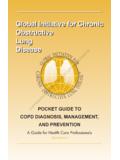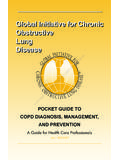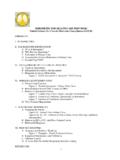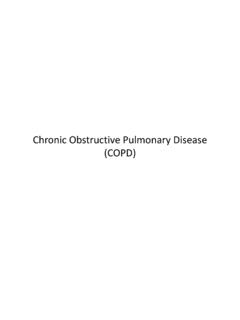Transcription of DIAGNOSIS, MANAGEMENT, AND PREVENTION A Guide for …
1 POCKET Guide TO COPDDIAGNOSIS, MANAGEMENT, AND PREVENTIONA Guide for Health Care Professionals2020 REPORTCOPYRIGHT MATERIAL - DO NOT COPY OR DISTRIBUTE i GLOBAL INITIATIVE FOR CHRONIC OBSTRUCTIVE LUNG DISEASE POCKET Guide TO COPD DIAGNOSIS, MANAGEMENT, AND PREVENTION A Guide for Health Care Professionals 2020 EDITION 2020 Global Initiative for Chronic Obstructive Lung Disease, Inc. COPYRIGHT MATERIAL - DO NOT COPY OR DISTRIBUTE ii GOLD BOARD OF DIRECTORS (2019) GOLD SCIENCE COMMITTEE* (2019) Alvar Agusti, MD, Chair Respiratory Institute, Hospital Clinic, IDIBAPS Univ. Barcelona and Ciberes Barcelona, Spain Richard Beasley, MD Medical Research Institute of NZ, Wellington, New Zealand Bartolome R. Celli, MD Brigham and Women s Hospital Boston, Massachusetts, USA Rongchang Chen, MD Guangzhou Institute of Respiratory Disease Guangzhou, PRC Gerard Criner, MD Temple University School of Medicine Philadelphia, Pennsylvania, USA Peter Frith, MD Flinders University Adelaide, Australia David Halpin, MD Royal Devon and Exeter Hospital Devon, UK M.
2 Victorina L pez Varela, MD Universidad de la Rep blica Montevideo, Uruguay Maria Montes de Oca, MD Hospital Universitario de Caracas Universidad Central de Venezuela Caracas, Venezuela Kevin Mortimer, MD Liverpool School of Tropical Medicine Liverpool, UK Sundeep Salvi, MD Chest Research Foundation Pune, India Claus Vogelmeier, MD University of Marburg Marburg, Germany Claus Vogelmeier, MD, Chair University of Marburg Marburg, Germany Alvar Agusti, MD Respiratory Institute, Hospital Clinic, IDIBAPS Univ. Barcelona and Ciberes Barcelona, Spain Antonio Anzueto, MD South Texas Veterans Health Care System, University of Texas, Health San Antonio, Texas, USA Peter Barnes, DM, FRS National Heart & Lung Institute, Imperial College London, United Kingdom Jean Bourbeau, MD McGill University Health Centre Montreal, Canada Gerard Criner, MD Temple University School of Medicine Philadelphia, Pennsylvania, USA Peter Frith, MD (retired 2019) Flinders University Adelaide, Australia David Halpin, MD Royal Devon and Exeter Hospital Devon, UK MeiLan Han, MD MS University of Michigan Ann Arbor, MI, USA Fernando J.
3 Martinez, MD MS New York-Presbyterian Hospital/ Weill Cornell Medical Center New York, NY, USA Maria Montes de Oca, MD Hospital Universitario de Caracas Universidad Central de Venezuela Caracas, Venezuela Alberto Papi, MD University of Ferrara Ferrara, Italy Ian Pavord, MA DM Respiratory Medicine Unit and Oxford Respiratory NIHR Biomedical Research Centre Nuffield Department of Medicine University of Oxford Oxford, UK Nicolas Roche, MD University Paris Descartes H pital Cochin APHP Paris, France Don D. Sin, MD St. Paul s Hospital, University of British Columbia Vancouver, Canada Dave Singh, MD University of Manchester Manchester, UK Robert Stockley, MD University Hospital Birmingham, UK M. Victorina L pez Varela, MD Universidad de la Rep blica Hospital Maciel Montevideo, Uruguay J rgen Vestbo, MD University of Manchester Manchester, England, UK Jadwiga A. Wedzicha, MD Imperial College London London, UK GOLD EXECUTIVE DIRECTOR GOLD PROJECT MANAGER EDITORIAL ASSISTANCE Rebecca Decker, MSJ Fontana, Wisconsin, USA Katie Langefeld, BS Illinois, USA Ruth Hadfield, PhD Sydney, Australia Michael Hess, MPH, RRT, RPFT, Kalamazoo, MI, USA *Disclosure forms for GOLD Committees are posted on the GOLD Website, COPYRIGHT MATERIAL - DO NOT COPY OR DISTRIBUTE iii TABLE OF CONTENTS TABLE OF CONTENTS.
4 III GLOBAL STRATEGY FOR THE DIAGNOSIS, MANAGEMENT, AND PREVENTION OF COPD .. 1 INTRODUCTION .. 1 DEFINITION AND OVERVIEW .. 1 OVERALL KEY POINTS: .. 1 WHAT IS CHRONIC OBSTRUCTIVE pulmonary DISEASE (COPD)? .. 1 WHAT CAUSES COPD? .. 2 DIAGNOSIS AND ASSESSMENT OF COPD .. 3 OVERALL KEY POINTS: .. 3 DIAGNOSIS .. 4 DIFFERENTIAL DIAGNOSIS .. 4 ASSESSMENT .. 7 Classification of severity of airflow limitation .. 8 Assessment of symptoms .. 8 Combined COPD assessment .. 10 EVIDENCE SUPPORTING PREVENTION AND MAINTENANCE THERAPY .. 12 OVERALL KEY POINTS: .. 12 SMOKING CESSATION .. 12 VACCINATIONS .. 13 PHARMACOLOGICAL THERAPY FOR STABLE COPD .. 15 Overview of the medications .. 15 Bronchodilators .. 15 Antimuscarinic drugs .. 15 Methylxanthines .. 16 Combination bronchodilator therapy .. 16 Anti-inflammatory agents .. 17 Inhaled corticosteroids (ICS) .. 17 Triple inhaled therapy .. 21 Oral glucocorticoids .. 21 Phosphodiesterase-4 (PDE4) inhibitors .. 21 Antibiotics.
5 22 Mucolytic (mucokinetics, mucoregulators) and antioxidant agents (NAC, carbocysteine) .. 22 Issues related to inhaled delivery .. 23 Other pharmacological treatments .. 23 REHABILITATION, EDUCATION & SELF-MANAGEMENT .. 23 pulmonary rehabilitation .. 23 SUPPORTIVE, PALLIATIVE, END-OF-LIFE & HOSPICE 24 Symptom control and palliative care .. 24 OTHER TREATMENTS .. 25 Oxygen therapy and ventilatory support .. 25 Ventilatory Support .. 25 Surgical Interventions .. 25 MANAGEMENT OF STABLE COPD .. 28 OVERALL KEY POINTS: .. 28 IDENTIFY AND REDUCE EXPOSURE TO RISK FACTORS .. 29 TREATMENT OF STABLE COPD: PHARMACOLOGICAL TREATMENT .. 30 Algorithms for the assessment, initiation and follow-up management of pharmacological treatment .. 32 TREATMENT OF STABLE COPD: NON-PHARMACOLOGICAL TREATMENT .. 36 Oxygen therapy .. 38 MONITORING AND FOLLOW-UP .. 40 MANAGEMENT OF EXACERBATIONS .. 40 OVERALL KEY POINTS: .. 40 TREATMENT OPTIONS .. 42 Treatment setting .. 42 Respiratory support.
6 44 Hospital discharge and follow-up .. 46 PREVENTION of exacerbations .. 47 COPD AND COMORBIDITIES .. 48 OVERALL KEY POINTS: .. 48 REFERENCES .. 48 COPYRIGHT MATERIAL - DO NOT COPY OR DISTRIBUTE 1 GLOBAL STRATEGY FOR THE DIAGNOSIS, MANAGEMENT, AND PREVENTION OF COPD INTRODUCTION Chronic Obstructive pulmonary Disease (COPD) is currently the fourth leading cause of death in the world1 but is projected to be the 3rd leading cause of death by 2020. More than 3 million people died of COPD in 2012 accounting for 6% of all deaths globally. COPD represents an important public health challenge that is both preventable and treatable. COPD is a major cause of chronic morbidity and mortality throughout the world; many people suffer from this disease for years and die prematurely from it or its complications. Globally, the COPD burden is projected to increase in coming decades because of continued exposure to COPD risk factors and aging of the This Pocket Guide has been developed from the Global Strategy for the Diagnosis, Management, and PREVENTION of COPD (2020 Report), which aims to provide a non-biased review of the current evidence for the assessment, diagnosis and treatment of patients with COPD that can aid the clinician.
7 Discussions of COPD and COPD management, evidence levels, and specific citations from the scientific literature are included in that source document, which is available from DEFINITION AND OVERVIEW OVERALL KEY POINTS: Chronic Obstructive pulmonary Disease (COPD) is a common, preventable and treatable disease that is characterized by persistent respiratory symptoms and airflow limitation that is due to airway and/or alveolar abnormalities usually caused by significant exposure to noxious particles or gases. The most common respiratory symptoms include dyspnea, cough and/or sputum production. These symptoms may be under-reported by patients. The main risk factor for COPD is tobacco smoking but other environmental exposures such as biomass fuel exposure and air pollution may contribute. Besides exposures, host factors predispose individuals to develop COPD. These include genetic abnormalities, abnormal lung development and accelerated aging. COPD may be punctuated by periods of acute worsening of respiratory symptoms, called exacerbations.
8 In most patients, COPD is associated with significant concomitant chronic diseases, which increase its morbidity and mortality. WHAT IS CHRONIC OBSTRUCTIVE pulmonary DISEASE (COPD)? Chronic Obstructive pulmonary Disease (COPD) is a common, preventable and treatable disease that is characterized by persistent respiratory symptoms and airflow limitation that is due to airway and/or alveolar abnormalities usually caused by significant exposure to noxious particles or gases and influenced by host factors including abnormal lung development. Significant comorbidities may have an impact on morbidity and mortality. There may be significant lung pathology ( , emphysema) in the absence of airflow limitation that needs further evaluation (see Figure). COPYRIGHT MATERIAL - DO NOT COPY OR DISTRIBUTE 2 WHAT CAUSES COPD? Worldwide, the most commonly encountered risk factor for COPD is tobacco smoking. Nonsmokers may also develop COPD. COPD is the result of a complex interplay of long-term cumulative exposure to noxious gases and particles, combined with a variety of host factors including genetics, airway hyper-responsiveness and poor lung growth during The risk of developing COPD is related to the following factors: COPYRIGHT MATERIAL - DO NOT COPY OR DISTRIBUTE 3 Tobacco smoke cigarette smokers have a higher prevalence of respiratory symptoms and lung function abnormalities, a greater annual rate of decline in FEV1, and a greater COPD mortality rate than Other types of tobacco ( , pipe, cigar, water pipe)7-9 and marijuana10 are also risk factors for COPD, as well as environmental tobacco smoke (ETS).
9 11 Indoor air pollution resulting from the burning of wood and other biomass fuels used for cooking and heating in poorly vented dwellings, is a risk factor that particularly affects women in developing countries. 12,13 Occupational exposures including organic and inorganic dusts, chemical agents and fumes, are under-appreciated risk factors for COPD. 12,14 Outdoor air pollution also contributes to the lungs total burden of inhaled particles, although it appears to have a relatively small effect in causing COPD. Genetic factors such as severe hereditary deficiency of alpha-1 antitrypsin (AATD) 15 ; the gene encoding matrix metalloproteinase 12 (MMP-12) and glutathione S-transferase have also been related to a decline in lung function16 or risk of Age and sex aging and female sex increase COPD risk. Lung growth and development any factor that affects lung growth during gestation and childhood (low birth weight, respiratory infections, etc.)
10 Has the potential to increase an individual s risk of developing COPD. Socioeconomic status Poverty is consistently associated with airflow obstruction18 and lower socioeconomic status is associated with an increased risk of developing ,20 It is not clear, however, whether this pattern reflects exposures to indoor and outdoor air pollutants, crowding, poor nutrition, infections, or other factors related to low socioeconomic status. Asthma and airway hyper-reactivity asthma may be a risk factor for the development of airflow limitation and COPD. Chronic bronchitis may increase the frequency of total and severe Infections a history of severe childhood respiratory infection has been associated with reduced lung function and increased respiratory symptoms in adulthood. 22 DIAGNOSIS AND ASSESSMENT OF COPD OVERALL KEY POINTS: COPD should be considered in any patient who has dyspnea, chronic cough or sputum production, a history of recurrent lower respiratory tract infections and/or a history of exposure to risk factors for the disease.












